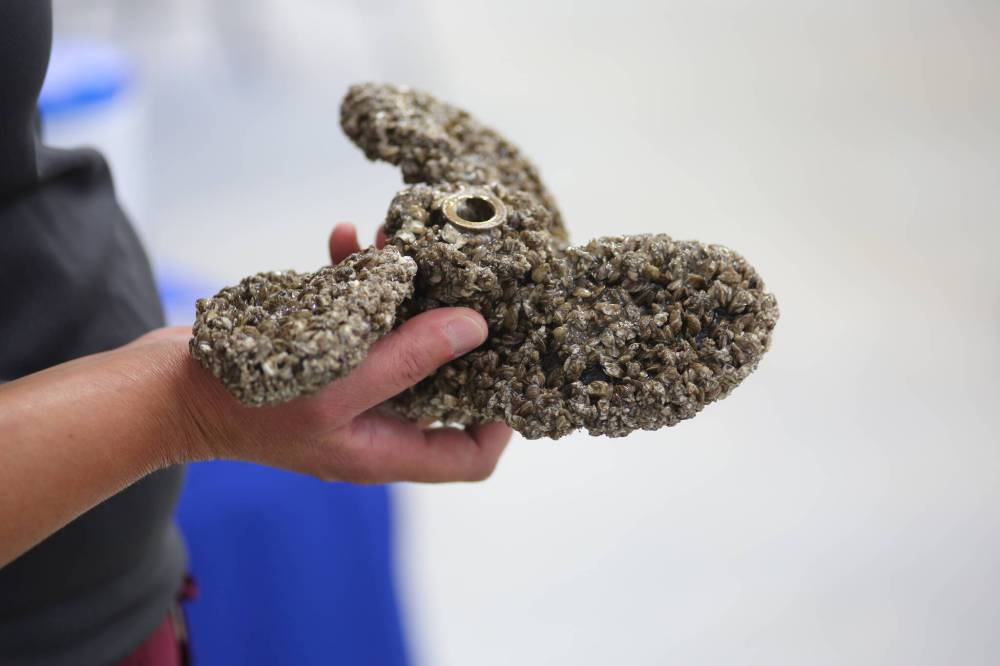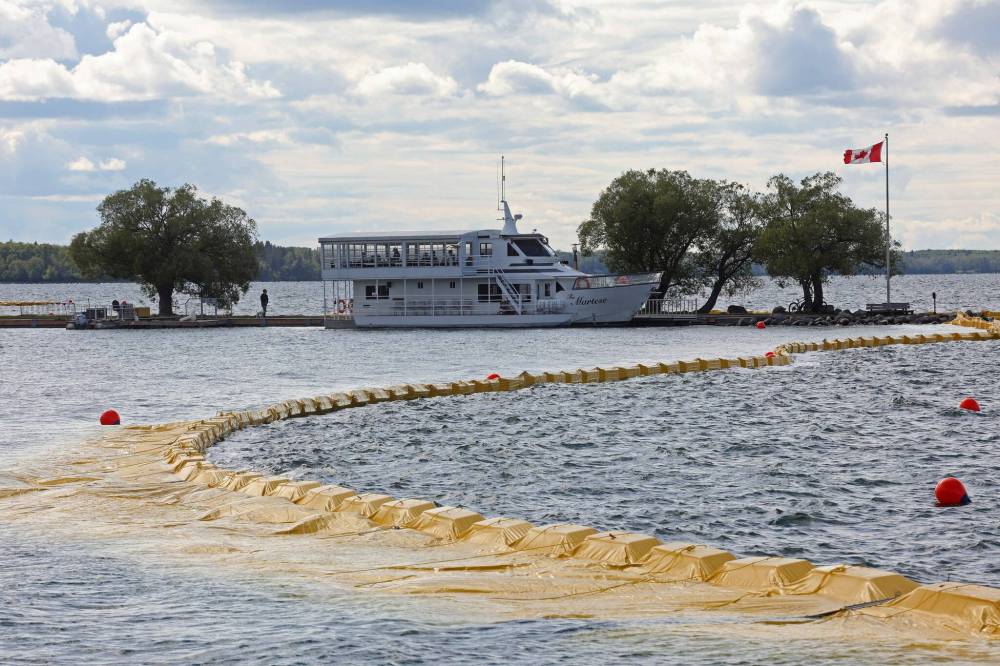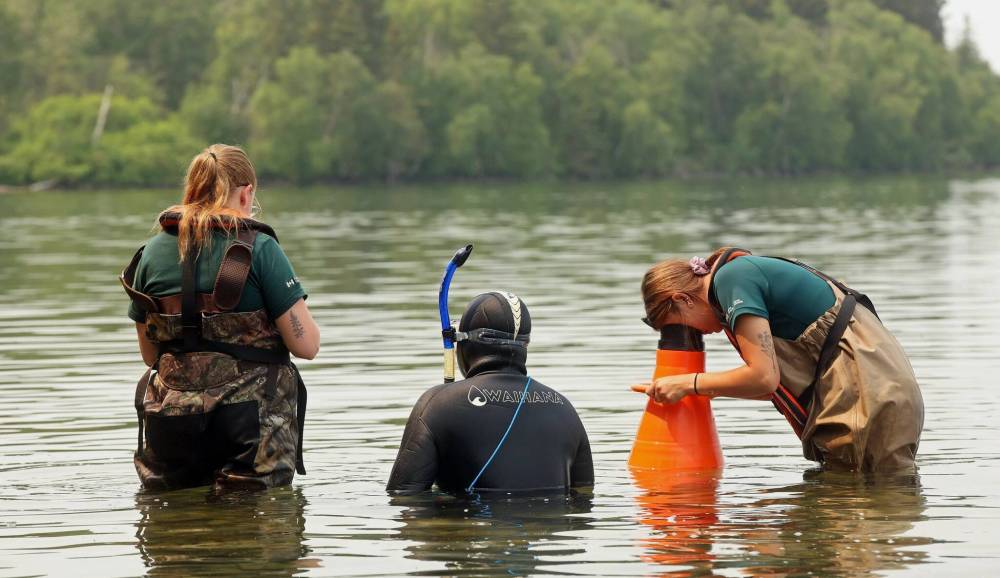Mussel spasm Despite all-out effort to keep them out, highly invasive mollusks infiltrate Clear Lake on westward march
Read this article for free:
or
Already have an account? Log in here »
To continue reading, please subscribe:
Monthly Digital Subscription
$0 for the first 4 weeks*
- Enjoy unlimited reading on winnipegfreepress.com
- Read the E-Edition, our digital replica newspaper
- Access News Break, our award-winning app
- Play interactive puzzles
*No charge for 4 weeks then price increases to the regular rate of $19.95 plus GST every four weeks. Offer available to new and qualified returning subscribers only. Cancel any time.
Monthly Digital Subscription
$4.99/week*
- Enjoy unlimited reading on winnipegfreepress.com
- Read the E-Edition, our digital replica newspaper
- Access News Break, our award-winning app
- Play interactive puzzles
*Billed as $19.95 plus GST every four weeks. Cancel any time.
To continue reading, please subscribe:
Add Free Press access to your Brandon Sun subscription for only an additional
$1 for the first 4 weeks*
*Your next subscription payment will increase by $1.00 and you will be charged $16.99 plus GST for four weeks. After four weeks, your payment will increase to $23.99 plus GST every four weeks.
Read unlimited articles for free today:
or
Already have an account? Log in here »
Hey there, time traveller!
This article was published 14/02/2025 (325 days ago), so information in it may no longer be current.
For months, a battle was waged at Clear Lake, the jewel of Riding Mountain National Park.
The mission? To halt the spread of an invasive species that’s wreaked havoc on lakes and rivers from Hudson Bay to the Gulf of Mexico.
Parks Canada tried rigorous testing and monitoring, then banned almost all boats and installed an 1,800-metre mesh curtain in an attempt to contain the threat.
But in January, as an undetermined number of fingernail-sized zebra mussels clung almost (but not quite) dormant to the rocks deep beneath Clear Lake’s frozen surface, Parks Canada was forced to admit defeat.
The western frontier has been breached. The mussels will march on.
In just 40 years since zebra mussels were discovered in Lake Erie, they have infiltrated waterways in four provinces and 31 U.S. states, including all five Great Lakes, the Mississippi River and Manitoba’s largest water bodies.
Clear Lake is the westernmost body in Canada to be infected. The mussels have left a trail of costly damage in their wake.
Kyle Darbyson / The Brandon Sun files Adult zebra mussels colonized on a boat propeller
“It was sort of an inevitable aspect of invasion biology, as unfortunate as it is,” Caleb Hasler, a biology professor and local fisheries expert at the University of Winnipeg, said of the mussels’ spread through Clear Lake.
In a late-January news release, Parks Canada announced it would reopen the lake to boaters in 2025, albeit under a “one boat, one lake” program, after finding hundreds of young zebra mussels on the eastern side of the lake — a couple of kilometres east of the main marina where staff first found evidence of the invasive species.
“Data gathered in 2024 demonstrated that zebra mussels are much more spread out in the lake than initially thought,” Parks Canada said in an email.
“As such, an eradication attempt would not be feasible.”
Though only one small creek flows out of Clear Lake, it links to the Little Saskatchewan and Assiniboine rivers, which meander across southern Manitoba and connect to a long list of rural communities, power-infrastructure sites, agricultural lands and, eventually, Winnipeg.
Experts expect zebra mussels will make their way down the chain. With no natural predators, zebra-mussel densities can reach up to 700,000 mussels per square metre and they tend to congregate on — and clog up — water intakes, irrigation systems and other underwater structures.
“The thinking is that these things are just going to keep their march west,” Hasler said of their inevitable spread.
Last May, just before the unofficial launch of Riding Mountain’s summer tourism season, park staff banned all but a handful of boats from Clear Lake’s shimmering waters. It was a blow to the tourism economy in the resort town of Wasagaming.
Kelsey Connor, owner of the Clear Lake Marina, relies on boat rentals and tours to keep his business afloat.
The impact of the ban, which was announced a week before May long weekend, was “profound,” he said in an interview, even though one of his tour boats, the Martese, was originally granted an exemption.
Other businesses reported a dent in summer bookings and an uptick in cancellations as news rippled through the province.
Parks Canada, however, believed a blanket ban was the best defence against the further spread of zebra mussels.
Tim Smith / The Brandon Sun files Parks Canada announced last May that all personal watercraft were to be banned from use on Clear Lake as part of work to determine whether zebra mussels had established a presence in the lake.
Staff had discovered the first signs of a possible zebra mussel infestation in January 2023, after more than a decade of water sampling.
Researchers weren’t sure how long the mussels had been there, or how widespread they had become, but felt banning boats would minimize the risk of mussels taking hold in other parts of the 30-square-kilometre lake.
“There is a very small window before those creatures become widely established throughout the waterbody, where it’s possible to have an intervention that entirely gets rid of them,” Dameon Wall, Riding Mountain National Park’s media relations manager, said at the time.
Zebra mussels don’t swim. Their larvae, called veligers, float on natural currents looking for a hard surface to attach to for the rest of their two- to five-year lifespan.
Once they land, the only way they move is if the surface they’re attached to — a boat hull, for example — moves for them.
Every year, a female zebra mussel can release up to one million invisible veligers and once they’ve established a presence, they’re nearly impossible to get rid of. It’s a successful Trojan Horse tactic for the invasive species.
If Parks Canada wasn’t successful eradicating it, Wall said: “they are in essence permanent — or at least until the next Ice Age comes along — and they would be all the way from Clear Lake to The Forks and downtown Winnipeg.”
Hoping the mussels hadn’t spread far beyond Boat Cove, Parks Canada elected to install a weighted, mesh-like curtain around the infested area and assess whether potash treatment — a Health Canada approved molluscicide that can be prohibitively expensive on a large scale — would be feasible.
The curtain was almost two kilometres long and cost nearly $850,000, park staff said in an email last summer.
Tim Smith / The Brandon Sun files A containment curtain set up in Clear Lake failed to prevent the spread of zebra mussels.
Contractors began installing the curtain on a windy day in late July, while the lake sat devoid of its usual clusters of kayaks, paddleboards and fishing boats. The installation was nearly complete by Aug. 6. Two days later, high winds tore the curtain from its moors.
No potash treatment was conducted.
“When that thing failed it sucked so much because I had to go walking down the pier every single day and look at it,” Connor said.
“This disgusting, plastic, yellow thing just floating there, not actually doing anything. That was really frustrating.”
Ultimately, Parks Canada isn’t sure whether an intact curtain and a dose of potash would have helped.
“Based on size, growth rates and numbers found, establishment likely occurred earlier in the summer, before the curtain was installed,” the department said in its January release.
It’s not yet understood what impact unmitigated zebra-mussel spread will have on the health — or future enjoyment — of the lake.
The mussels are now “prevalent throughout the eastern third of the lake’s surface area,” though “the full extent of the population is not yet known,” Parks Canada staff confirmed in an email.
Staff said zebra mussels are likely to “negatively impact the existing ecology … by altering food chains, water quality and aquatic habitats” — in other words fish, insect and other mussel populations will likely decline.
But their impacts are far wider reaching.
Their razor sharp, striped shells already litter the sand of beaches throughout the province and contribute to toxic blue-green algal blooms.
The Brandon Sun files Parks Canada employees conduct visual inspections for signs of zebra mussels near Boat Cove at Clear Lake in July, 2024. 
Connor wonders if Clear Lake will experience the same: “Are we going to have to wear water shoes all the time? How prolific are they going to be?”
And then there are the risks to infrastructure.
Parks Canada plans to monitor the park’s outlying lakes and Wasagaming’s water-treatment infrastructure, but its management responsibilities end where Wasamin Creek begins — and that’s exactly where things get complicated.
“The treatment of water leaving Clear Lake is unrealistic from both engineering and sustainability perspectives,” Parks Canada said in an email.
“There is no way to prevent, or significantly slow, the outflow without significant damage to the townsite of Wasagaming, or to the ecological integrity of the area.”
The one small outflow from Clear Lake trickles about 12 kilometres until it joins the Little Saskatchewan River, which flows south into the Assiniboine River. Its course winds through several rural municipalities, through Brandon and eventually into the heart of Winnipeg.
“My concern is that any rocky beaches, any input or output pipes related to agricultural drainage, any pumps related to irrigation, municipal water intakes and hydropower … you would expect to have veligers settle on and then zebra mussels would develop,” said Hasler, the biology professor.
“It would require cleaning and maintenance to keep zebra mussels clear of those things.”
Manitoba Hydro operates a generating station on the banks of the Assiniboine in Brandon, and is already preparing to protect the generator from invasion.
The provincial utility has experience fighting off zebra mussels at many of its northern dams, where it uses chlorine to clear off dense populations.
As for the other critical infrastructure in the mussels’ path, the province will need to provide support.
In an interview, Manitoba Environment and Climate Change Minister Mike Moyes said the province wants “to do everything possible to ensure that aquatic invasive species are not spreading.”
Moyes pointed to a $500,000 increase for invasive-species management that was announced in the 2024 budget and has largely been spent expanding the provincial boat inspection and decontamination program.
Last July, the province committed to increasing water sampling to detect any downstream spread. Moyes said more testing occurred through the summer, though he could not provide specifics. The sampling efforts will resume in spring, he said.
The department has also met with municipalities in recent weeks to work on prevention strategies, such as early detection and enforcement of boat decontamination regulations.
Moyes said the province does not want to think of zebra mussels’ march into Wasamin Creek and downstream river systems as an inevitability.
“When that happens, folks will say it’s too late, and I don’t believe that’s the case. The folks I’ve been speaking with… are not saying that we should just throw up our hands, but instead encourage Manitobans to ensure that we’re being more diligent, that we’re doing everything that we can in our power to prevent that spread.”
Parks Canada isn’t sure how far the mussels will be able to travel downstream, or whether they will find the right habitat to establish populations and reproduce.
The mussels need enough calcium and food in the water and enough hard surfaces to cling to in order to survive, Hasler explained. If Clear Lake meets those conditions, it’s likely the creek will too.
“The better thing to do is just keep in mind that this is something that’s coming down the system and that we should implement monitoring sooner rather than later because then you can start maintenance if you need it,” Hasler said.
Boats will be back on the lake this summer. Parks Canada has returned to the one-boat, one-lake rules first put in place in 2023, which aim to prevent invasive species being spread to unaffected waterways.
Park staff consulted with community members and visitors in early February to help determine exactly what the policies will entail.
Christian Robin, president of the Clear Lake Cabin Owners’ Association, believes this approach “strikes the right balance” in both protecting the lake and encouraging its enjoyment.
“I think the presence of zebra mussels will have an impact on the health of the lake, but it’s difficult to know exactly how,” Robin said in an email.
“I’m an optimist, so I’m hopeful the lake will adapt and thrive, but in a different way.”
“I’m an optimist, so I’m hopeful the lake will adapt and thrive, but in a different way.”–Christian Robin, president of the Clear Lake Cabin Owners’ Association
Connor is on the same page.
“This place is still amazing and people are still going to come here,” he said. With boats back on the lake, he added, “I’m really excited to do business again.”
Connor’s business was affected by the boat ban, but as someone whose childhood was peppered with trips to the national park, his main concern was always the lake itself.
“Clear Lake is something totally different. I’m really happy to live in a place and have an organization that draws a line in the sand somewhere and tries to take action when it’s deemed necessary,” he said of last summer’s restrictions.
“The long-term success of our business … revolves around the health of Clear Lake.”
julia-simone.rutgers@freepress.mb.ca

Julia-Simone Rutgers is the Manitoba environment reporter for the Free Press and The Narwhal. She joined the Free Press in 2020, after completing a journalism degree at the University of King’s College in Halifax, and took on the environment beat in 2022. Read more about Julia-Simone.
Julia-Simone’s role is part of a partnership with The Narwhal, funded by the Winnipeg Foundation. Every piece of reporting Julia-Simone produces is reviewed by an editing team before it is posted online or published in print — part of the Free Press‘s tradition, since 1872, of producing reliable independent journalism. Read more about Free Press’s history and mandate, and learn how our newsroom operates.
Our newsroom depends on a growing audience of readers to power our journalism. If you are not a paid reader, please consider becoming a subscriber.
Our newsroom depends on its audience of readers to power our journalism. Thank you for your support.










